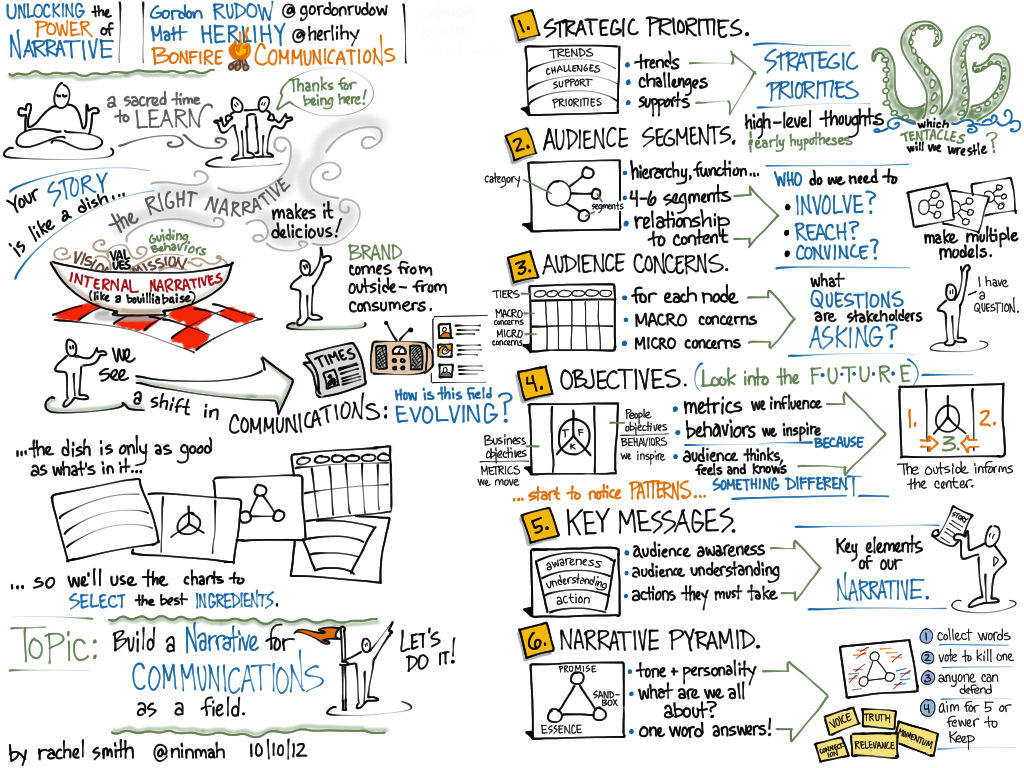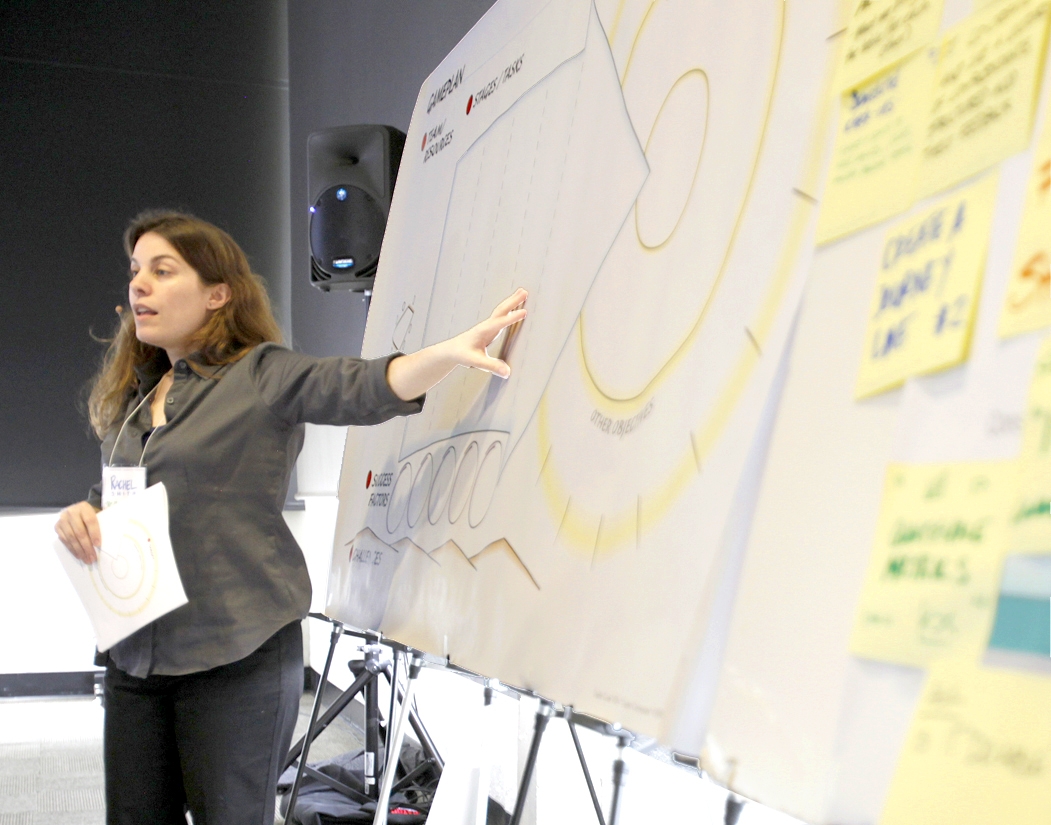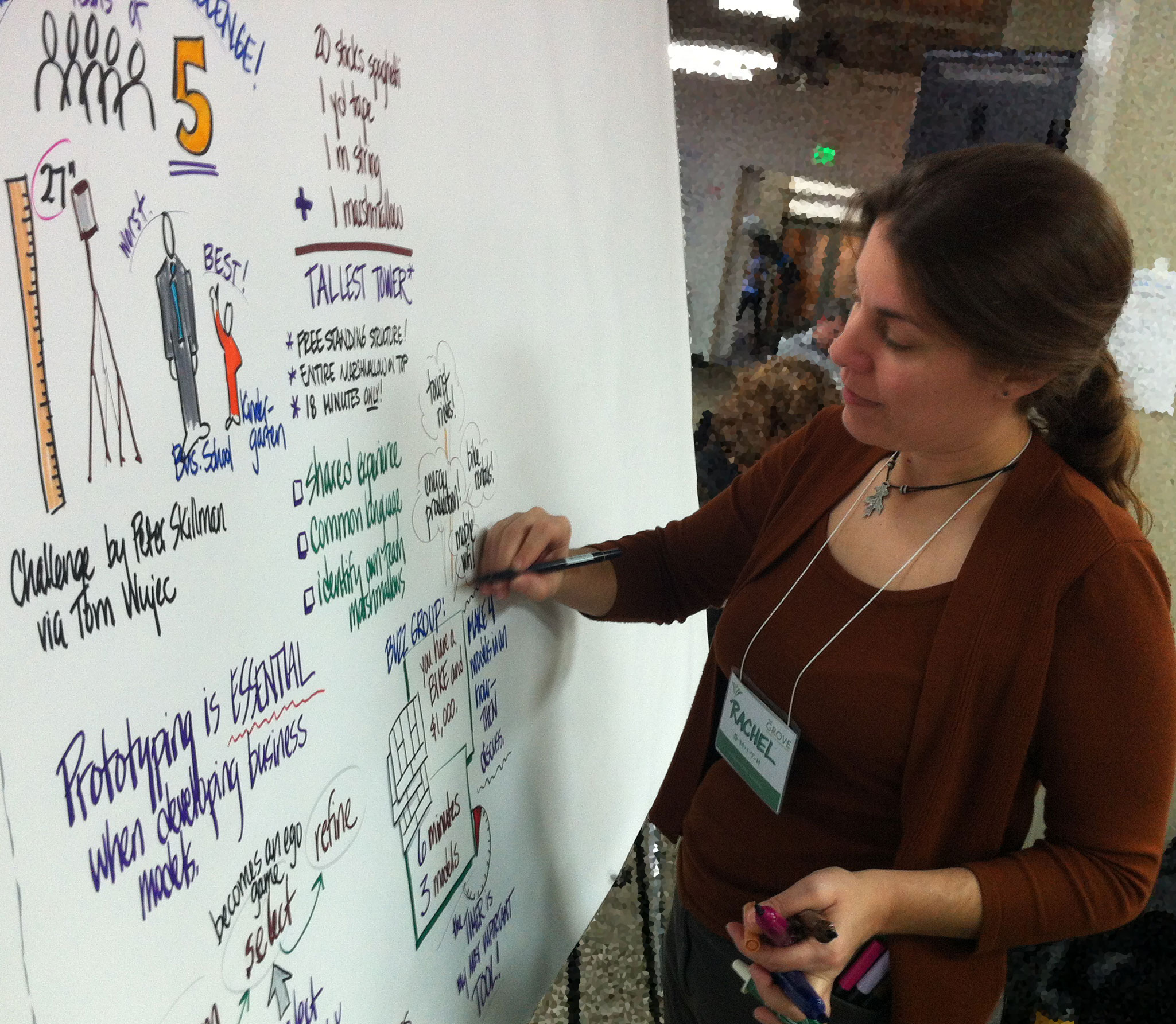Disruption, Innovation And The Necessity Of Creative/Engaged Collaboration

The art of disruption and collaborative innovation is a very complex and often sensitive topic. In my line of work (as an innovator and disruptor), I am brought into medium and large enterprises with the explicit mission of breaking things to identify and collaborate on new areas of business. We hit many levels of resistance and often closed and blocked receptors about new possibilities.
I have found that PowerPoints and presentations are not only old school but they do not work. In fact, the moment your PPT presentation goes up, the minds of the audience start disengaging. Most often people don’t take notes as they feel they can review the slides later — super bad idea. It becomes a one way lecture and dialog. Instead, along with ProVoke and the ProVoke Methodology a few years ago, I started deploying a very different model. One of the great methodologies is to involve visual facilitation and collaboration methods to convert the audience from PASSIVE LISTENERS TO ACTIVE PARTICIPANTS! My sessions with clients are very different than normal lectures (fyi- I do the same when I teach at universities as well — engage instead of speak-to your audience):
1. 10-15 minutes chunks of time where I share a few thoughts/ideas. Often with whiteboarded and as few PPTs as possible! We set the stage for the topic which we are going to collaborate on.
2. Next, the audience in groups or individually start working on ideas and thinking through the topic which was just discussed.
3. In parallel, working with extremely talented visual facilitators and thinkers, we start removing the layers, in order to go deep into the mission of disruption and innovation. To Disrupt, we have to break apart what is there today, almost like a therapy session as we work through the issues.
4. Turn into a group effort and begin the art of active and true collaboration.
I started including visual facilitation and collaboration methodologies in my practice about a decade ago. I believe in the power of the mind but I also know that for many reasons (topic of my book ProVoke) we (humans) resist change, specially in large enterprises. We don’t draw or simply record thoughts. Rather, we collectively uncover hidden reasons and untold stories which allow us to innovate. Remember my mission: Disrupt to innovate.
One of the groups that I love is The Grove Consultants in San Francisco. In particular, I am extremely impressed with one of the senior visual facilitators, Rachel Smith. Working with Rachel is a true pleasure as we form a duo to use different lenses to disrupt and innovate.
So, to familiarize you with the art of visual facilitation, I decided to do a brief Q&A with Rachel. And to be clear, for all who think this is an art of ‘cartooning and drawing thoughts’ that is totally incorrect. I call it the art of uncovering the unknown. To disrupt, we first need to remove and discard the old layers (thoughts) and go deep even when it is difficult.
Q&A With Rachel Smith – The Grove Consultants International
 Question 1. Hello Rachel. I must say it is a great pleasure knowing you and The Grove Consultants. Can you tell our readers a bit about you and your background and The Grove Consultants please?
Question 1. Hello Rachel. I must say it is a great pleasure knowing you and The Grove Consultants. Can you tell our readers a bit about you and your background and The Grove Consultants please?
Rachel: Hi Linda, the pleasure is definitely mutual! The work you are doing to help companies disrupt, innovate, and think creatively is so important. Creativity is where I live, too, and it’s where I come from. My formal training is actually in art education, and I was a public-school art teacher in Florida and later a multimedia instructor in the Stanford University Media Lab. I’ve been a graphic designer, a user interface designer, a researcher and writer, and a trainer and facilitator. Now I’m very happy to be working as a senior consultant for The Grove Consultants International, here in San Francisco. We specialize in organizational change, strategic visioning, team development, and of course, graphic facilitation. The Grove was founded by David Sibbet, who started the field of graphic facilitation back in the 1970s.
Question 2. As you and our readers know I have been an avid advocate of including graphic facilitation and recording as an active part of collaboration. Particularly in my work in disruption and innovation. Can you help our readers get educated on ‘what’ graphic facilitation and recording is, and dismiss some of the myths please!
Rachel: Of course! First, it’s important to understand that there are two activities here, graphic facilitation and graphic recording. Both practices support group process with large-scale visual displays created during meetings or in similar contexts. A graphic facilitator guides the process toward agreed-upon outcomes, mediates discussions, and records what is said on giant sheets of paper using both words and images. Graphic recording is very similar, except that the role of facilitating the process and mediating discussions is taken on by another person. The graphic recorder focuses on capturing and organizing the information, and the two work in tandem.
For both activities, it’s important for the group to see what is being recorded. The charts need to capture exact words used by the participants, and images need to be relevant and not simply decorative. The graphic facilitator or recorder also has an important role in helping to organize the information so that the group can see connections and insights. Ideally, the charts should remain in the meeting space once they are complete, so the group can refer to them as the meeting continues.

The Grove Consultants host a Visual Teams Workshop at Ft. Mason in San Francisco, CA on March 29, 2012. © Vance Jacobs 2012.
One of the most common myths is that all graphic facilitators are artists or illustrators who map the discussion using only images. There are lots of facets to visual practice. While image-based graphic recording is one of the facets, it certainly isn’t the whole picture. Many graphic facilitators don’t self-identify as artists, and some really don’t like being called artists at all. There’s a skill to organizing the information, externalizing the conversation so that ideas can be handled almost like tangible objects. If I’m doing that using only pictures, the group won’t recognize itself in the chart—they need to see actual words that were spoken in the room for it to really belong to them. The charts that I create are not art, but useful tools to help the group do its work.
Another myth that I’d like to dispel is that simply having a graphic recorder in the room is always helpful, even if they are positioned behind the group and no one interacts with them at all. The strength of graphic facilitation is really felt by a group when they can see the visual record, interact with it, and use it to make connections and find insights that aren’t otherwise apparent. I’m always amazed when I’m invited to record a meeting and they try to put me in the back where no one can see what I’m doing. That’s visual note-taking, not graphic facilitation. Personal visual note-taking like this can certainly be a valuable contribution, when it serves the outcomes of the group. But generally speaking, the client is not getting their money’s worth if the facilitator can’t partner with the graphic recorder.

Question 3. Yes, I could not agree with you more! To best utilize your skills/strength is to allow everyone to interact with you. I had another question for you: To disrupt and innovate we need to be untraditional, ruthless and dig deep to uncover resistances and thoughts that inhibit us from accepting change. Can you explain why your methodology is so key in enabling this aspect of learning and collaboration?
Rachel: One of the reasons is that graphic facilitation makes it easier to get clarity on complex ideas. If something is written down and sketched out, it’s easier to identify gaps in understanding or areas where an idea isn’t quite complete. People can work faster and more efficiently because they are talking about the same thing, and they can see when they are understanding each other.
Another reason is that it becomes clear very quickly when the surface ideas, the easy pickings, have been captured, so the group can move on to the deeper levels. Getting all the surface stuff out and making it visible paves the way for some of that deeper digging. Also, the group can see the big picture and the details at the same time, so they can move back and forth as needed. That can be very hard to do without visual support.
I would also say that graphic facilitation is itself still pretty untraditional, despite the fact that it’s becoming more widespread. So when a group walks into a room with paper on the walls and markers on the table and giant sticky notes and visual agendas, they think, “Hey, this is different. What’s going on here?” The space itself can help get them into a more untraditional, innovative frame of mind.
I’ve used graphic facilitation to help groups talk about their resistances—the behaviors and attitudes that get in the way of accepting change. What I’ve found is that when they actually see a chart describing all the stuff they fear and the roadblocks that are preventing them from getting where they want to be, the group is able to make the turn to tackling those roadblocks. It’s empowering to name all that stuff, list it all out on a sheet of paper, and realize that it’s not an infinite list and that you really can do something about it, even if it’s a bit at a time.
Question 4. In my work with graphical and visual recording and facilitation I have seen amazing results, like being able to extract thoughts that participants at times were not aware that they had, or otherwise changing the course of a conversation… given your strong background in education, can you share some stories and insights of the ‘amazing stuff’?! One example which is always fascinating to watch is when words are uncovered by listening to folks who would ordinarily be very shy or unable to express themselves. I always insist to have the recordings on walls for weeks and I love seeing those same quiet individuals bring colleagues to show their input with pride. To see their thoughts in words and visible is a very moving experience.
Rachel: You know, there are so many examples of graphic facilitation changing the whole course of a conversation. I think one of the best things that can happen is when someone says something, and the group doesn’t get it at first. But then either they see the graphic recording and understand better, or they realize they need to ask more questions, or sometimes the speaker sees the recording and realizes he wasn’t clear in the first place. Just holding up that mirror to the language in the room can help people make that connection and bring clarity to a discussion.
Another one that is really something to see is the person who doesn’t often contribute or is very soft spoken, but who has really great ideas that get passed over because of their communication style. Those people sometimes just blossom when they say something and I capture it—because as a graphic facilitator, you add something to the chart whenever anyone speaks—and there it is on the chart, just as ‘loud’ as everyone else’s ideas. The group can pick up on the idea and run with it, and the shy person feels very validated.
The other thing that always amazes groups that I’ve worked with is the realization at the end of the meeting of just how much work they got done. They are just astonished at how long they were able to focus, how many decisions they were able to make, how clear the issues are. And with graphic facilitation, you can actually see how much work you did—it’s hanging on the walls all around you!
As an educator, I learned the importance of dealing with multiple modalities of learning and expression. Some people learn best by reading; some by thinking out loud; some by listening; some by quiet reflection. With graphic facilitation, you can reach all of those people at different times. It can really transform the group dynamic and draw greater contribution from people who may find it hard to participate in a traditional, words-only meeting.
Linda: I’m really looking forward to partnering with you more, and supporting teams as they disrupt, innovate, and tap into their own incredible creativity!
Rachel: The pleasure is all mine and look forward to disrupting and innovating together in the future.
Wow! And to make all of this even more exciting:As many of your know, we have created a highly collaborative platform for innovation called ProVoke LiVe NetWork, PLN. In order to enhance our collaboration environment, we took the bold and highly creative step of integrating live animation during virtual collaboration sessions. To see PLN in action and how we integrate animation, please watch this video:
Via PLN, we can recreate the collaboration environment which we would have live in-person, virtually with participants and presenters around the world. Our philosophy of having producers (led by our Executive Producer) in charge of our virtual sessions, multiple studios and having all sessions recorded and content shared digitally, allows us to have highly productive collaboration sessions virtually. PLN Is ready, are you READY?
Conclusion: I expect to be working with many of you as we collaborate to disrupt and innovative using our methodology. Until then if you are skeptical or intrigued (hope it is the latter) let us know and we will set up a session to familiarize you with the art of active and mindful collaboration!

